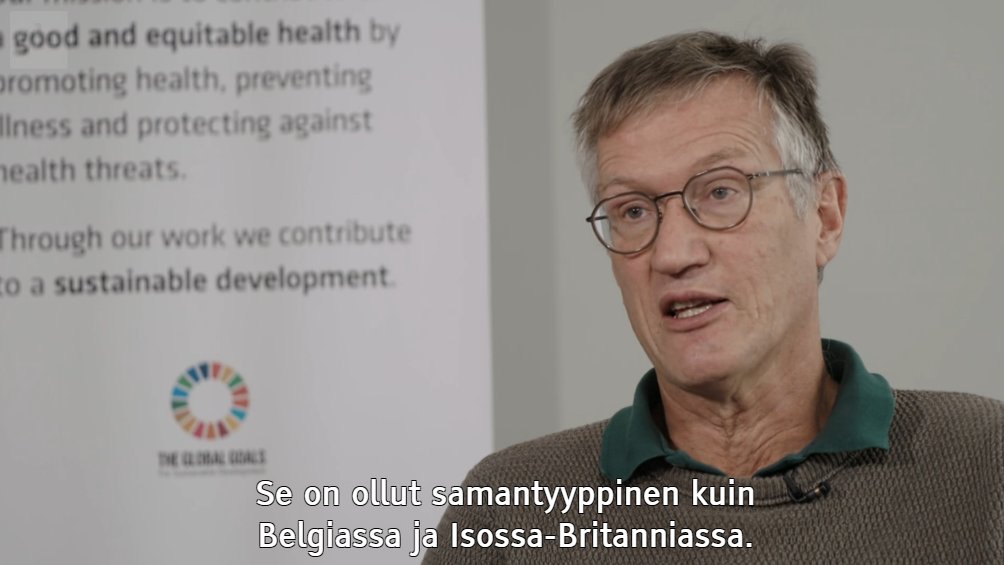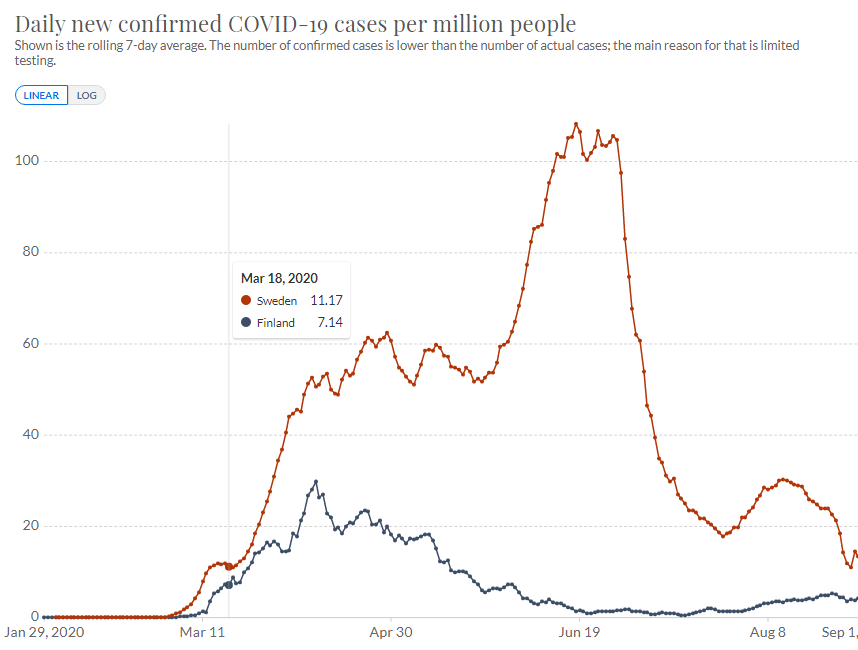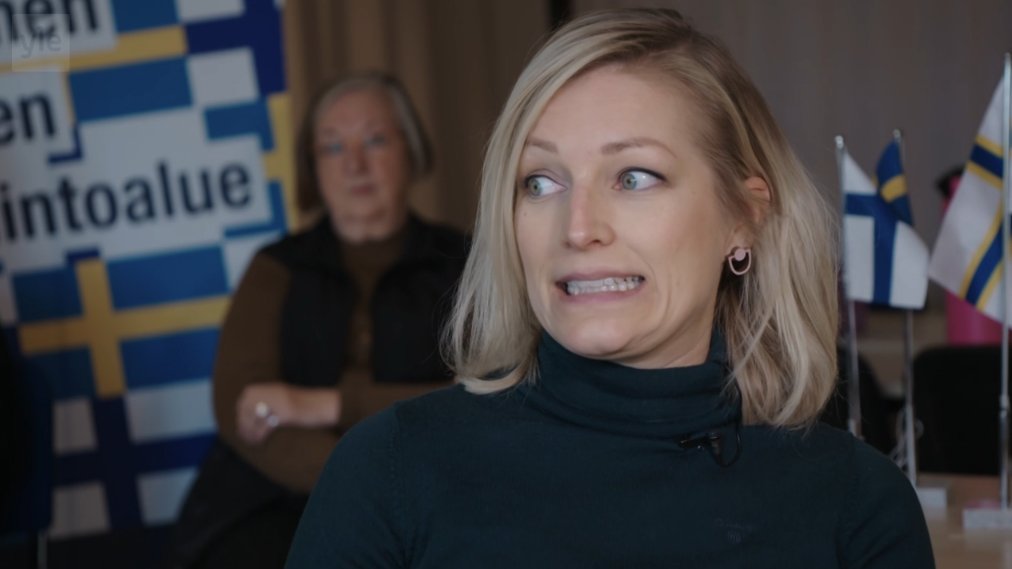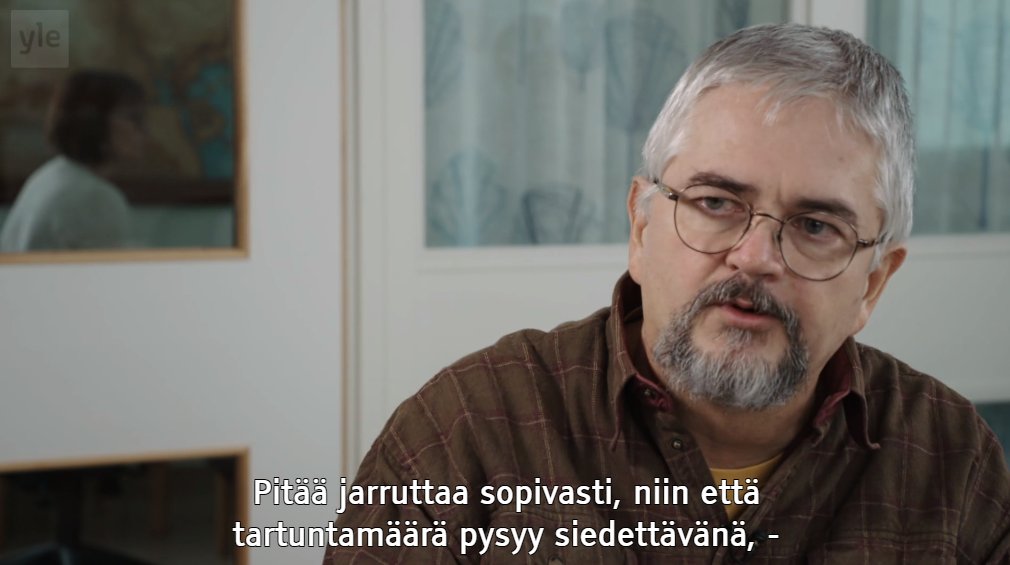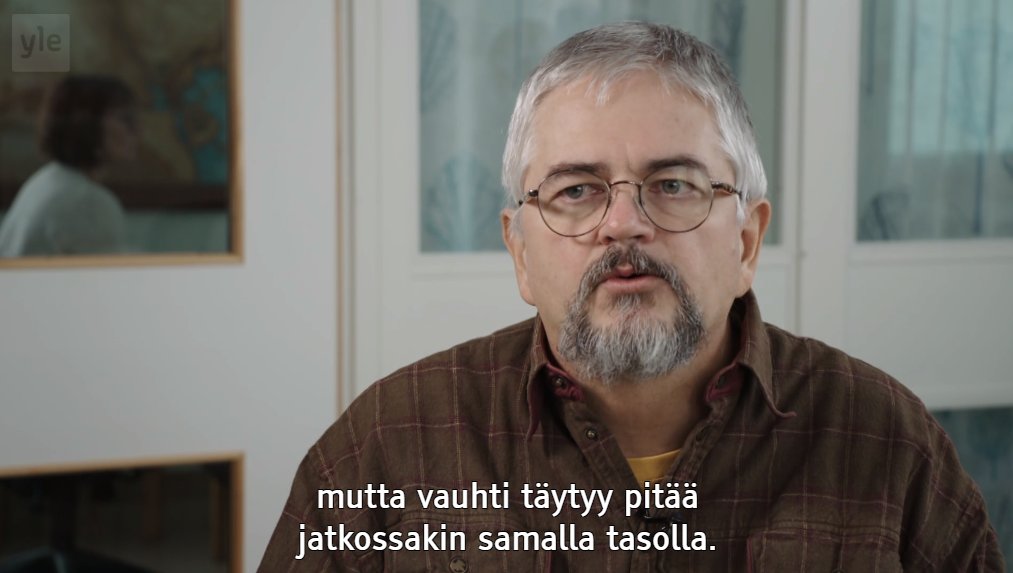I'm watching an interesting Finnish documentary called Korona Ruotsissa ("Corona in Sweden"). Anyone can watch it but unfortunately it is only in Finnish except for some interviews which are in Swedish. I'll try to sum up parts of it. Thread.
Link: https://areena.yle.fi/1-50654859
Link: https://areena.yle.fi/1-50654859
It starts with an interview of a minister in the Finnish Church in Stockholm. Many in his congregation have died and have been buried without their families present. Finns have had the highest covid mortality in Sweden.
I'm sad to see they still don't know the risks of singing.
I'm sad to see they still don't know the risks of singing.
Narrator: 'Sweden's different approach to covid has raised questions around the world. In spring, it looked like the Public Health Agency believed that the high mortality would bring sufficient immunity. They have since then repeatedly denied herd immunity being the goal.'
Interview with a nurse who's been working in different elderly homes in Stockholm from 1990s. 'I remember the morning when I realised what's going on. I was leaving for work and said to my husband, 'I'm leaving now to kill old people.'
Narrator: 'In spring, the elderly homes in Stockholm received instructions that were meant to ensure the healthcare system wouldn't get overwhelmed.'
Nurse: 'They had decided the residents would not be taken to hospitals but instead cared for in the homes.'
Nurse: 'They had decided the residents would not be taken to hospitals but instead cared for in the homes.'
'The resources were highly limited, often no IV drips or oxygen. Instead, palliative care was prescribed systematically to those who got ill. There were a lot of them. We were instructed to give morphine and Midazolam which depress breathing and reduce the odds of survival.'
Narrator: 'Due to covid, doctors didn't visit the elderly homes like they usually do, which made the situation worse. They moved the patients to palliative care routinely on the phone without seeing the patient.'
Nurse: 'You don't necessarily die if you catch covid even if you're old. But if you're not treated, your chances are slim. If you can't eat or drink... You might need extra oxygen just for a few days to help your body to fight the virus.'
'You see quickly if it works or not. If it doesn't, maybe then you could start palliative care. The situation at work felt very, very difficult. It felt unethical. Who has the right to decide on someone's life or death? It was euthanasia and often timed wrong. It's unacceptable.'
Anders Tegnell (in Swedish, 07:30): We know there have been problems in elderly care: lack of medical competence, hourly paid workers couldn't stay at home when sick. The problems have been fixed, which has stopped the spread in elderly homes.
Tegnell: 'It is a clear sign the Swedish strategy was not to blame. It was the work in elderly homes that needed improving.'
The interviewer ( = narrator = Minna Pye) compares the death rates between the Nordic countries and asks if it's acceptable that the number is so high in Sweden.
Tegnell: Of course not. We hope we could have prevented it. It was absolutely not part of the strategy.
Tegnell: Of course not. We hope we could have prevented it. It was absolutely not part of the strategy.
Tegnell: But it happened. We understand some of it. Many special nursing homes (särskilda äldreboende) were bad at keeping the disease away. Very many got sick. In Sweden, 70 000 - 80 000 people live in special nursing homes. A big % of them got sick and died.
Minna Pye:
The Health and Social Care Inspectorate (IVO) evaluated in November that the shortcomings in the elderly care were systematic. Majority of treatment decisions were made on the phone, and 20% didn't get an individual care assessment.
The Health and Social Care Inspectorate (IVO) evaluated in November that the shortcomings in the elderly care were systematic. Majority of treatment decisions were made on the phone, and 20% didn't get an individual care assessment.
Pye:
Tegnell says the reason for the high death rate is, besides the shortcomings in elderly care, also that the pandemic has been worse in Sweden than in the neighbouring countries.
Tegnell says the reason for the high death rate is, besides the shortcomings in elderly care, also that the pandemic has been worse in Sweden than in the neighbouring countries.
Tegnell (in Swedish, 09:46):
'The epidemic has been very different in Sweden compared to the neighbouring countries. It's been more like the epidemics in Belgium, the Netherlands and the UK. The number of cases grew very quickly at the beginning, unlike in Finland.'
'The epidemic has been very different in Sweden compared to the neighbouring countries. It's been more like the epidemics in Belgium, the Netherlands and the UK. The number of cases grew very quickly at the beginning, unlike in Finland.'
Tegnell: 'We never had the same chance as Finland to keep the spread down. Instead, we got a very violent epidemic, especially in Stockholm.'
My comment: Did Sweden really try? This is where Finland moved all schools to distance learning; Sweden did the same with high schools and universities. Soon Finland closed restaurants, public facilities, borders, the hardest-hit capital region. Sweden didn't; they stopped TTI.
I'll continue later.
Pye:
Sweden has relied on recommendations and regional measures. Swedish elderly have paid the highest price for it already at the start of the epidemic when covid started spreading uncontrollably in elderly homes.
Sweden has relied on recommendations and regional measures. Swedish elderly have paid the highest price for it already at the start of the epidemic when covid started spreading uncontrollably in elderly homes.
Nurse:
The care staff infecting the residents has been a huge problem. You could see it yourself how the virus moved from one room to the next. The staff were unqualified for the situation and didn't understand infections or viruses.
The care staff infecting the residents has been a huge problem. You could see it yourself how the virus moved from one room to the next. The staff were unqualified for the situation and didn't understand infections or viruses.
Interview with a Social Democratic* council member, also a board member at Gerontology Research Center. She blames the private sector: hourly paid unqualified workers, lack of PPE (also in the public sector).
(* the party responsible for the strategy)
(* the party responsible for the strategy)
Back to Finns. In Sweden, there are over 700 000 people with Finnish background. Among Sweden-Finns, covid mortality from March to early May was 145 / 100 000 people. Among people born in Sweden, it was 32 / 100 000. A Finnish deacon lists reasons: age, health, language.
Anders Tegnell on Sweden-Finns: They're older. Many have cardiovascular diseases. They are a group with a big risk to die. We're inspecting if there are also other reasons.
Interviewing Sweden-Finns.
- If you talk with Finns, they are horrified about the situation in Sweden. Swedes are very trusting and believe what you tell them. 'Yes, this is the only way that is right. Sweden is the world champion in the pandemic.' I think it's a huge failure.
- If you talk with Finns, they are horrified about the situation in Sweden. Swedes are very trusting and believe what you tell them. 'Yes, this is the only way that is right. Sweden is the world champion in the pandemic.' I think it's a huge failure.
Another Sweden-Finn:
- I think Swedes are really naive if you compare with Finns. We don't believe everything. Bad things can also happen.
Finn 1:
- In Finland, you make a decision and go with it. In Sweden, you avoid decisions. You talk and try to find solutions together.
- I think Swedes are really naive if you compare with Finns. We don't believe everything. Bad things can also happen.
Finn 1:
- In Finland, you make a decision and go with it. In Sweden, you avoid decisions. You talk and try to find solutions together.
Finn 3&4: We don't know yet which country, Finland or Sweden, will manage it better. You have to take personal responsibility. Consensus is important in Sweden. The officials give recommendations rather than tell you what to do.
Stockholm, mid-October.
Pye:
- Here in Drottninggatan in Stockholm you can see the difference between Sweden and Finland. In Finland, masks are now used widely. Here, life seems to go on as normal. In the evenings, restaurants and bars are full as if covid didn't exist.
Pye:
- Here in Drottninggatan in Stockholm you can see the difference between Sweden and Finland. In Finland, masks are now used widely. Here, life seems to go on as normal. In the evenings, restaurants and bars are full as if covid didn't exist.
Tegnell (in Swedish, 22:54): A big difference is that your existing laws have allowed closing down society. In Sweden, we have chosen voluntary measures and special laws. You have also the whole time had a bigger capacity to test and trace much more than we have done in Sweden.
Tegnell: Sweden got many cases very quickly, especially in Stockholm. The healthcare had to focus on treating patients. It wasn't possible to test or trace as much as we would have liked. In Finland it was possible.
Pye: Finns don't understand why Swedish approach is so different from that of other Nordic countries. What would you tell them?
Tegnell: Our approach is very similar. Sweden has closed down a lot. We've done it with voluntary & focused measures rather than closing all at once.
Tegnell: Our approach is very similar. Sweden has closed down a lot. We've done it with voluntary & focused measures rather than closing all at once.
Tegnell: We have restricted our restaurants a lot, for example. We have also had a kind of a lockdown, just more virtual and not as visible as in other countries. It has changed the lives of many Swedes very, very radically.
Interviewing a Sweden-Finnish singer-dancer. He says you can't perform in Sweden anymore.
Pye: How do you give dancing lessons during the pandemic?
He: There's a max. 30 people limit. We have to wash hands and keep distance.
Pye: How do you give dancing lessons during the pandemic?
He: There's a max. 30 people limit. We have to wash hands and keep distance.
The singer: - Sweden takes this very differently. Bars are full and people sit tight. No one thinks someone might have covid. It's been the same from the start.
Pye: - You haven't had to stop meeting people.
He: - I haven't, at least. You just don't need to hug them all the time.
Pye: - You haven't had to stop meeting people.
He: - I haven't, at least. You just don't need to hug them all the time.
The outbreak in Gällivare in the summer started from the annual maintenance of the mine. The situation was challenging for the local healthcare that didn't have the capacity of the bigger cities, but they managed.
Anders Nystedt, infection control doctor (Swedish, 29:05): - A lot of people came to tiny Gällivare. They had beers in the hotel bar / in a pub and shopped. They didn't keep distance or stay at home when sick. We got suddenly 600 cases in a town of 8000 people.
Nystedt, infection control doctor, continues with a #herdimmunity metaphor (31:12). - It's like driving on an icy road. If you brake too quickly, you end up in the ditch. You need to brake moderately and keep the infections at an acceptable level that the healthcare can cope.
- Right now the pace is suitable, but we have to keep it at this level. If it speeds up, we get (describes exponential growth) and that's dangerous. That's when the old and weak get infected and that's when we get deaths, and I don't think that's acceptable.
Pye: You know what measures Finland has taken. What do you consider the biggest differences between the two countries?
Nystedt: The differences are small. Finland has more extensive quarantines. The same goes with closing borders that Sweden hasn't done. They make a difference.
Nystedt: The differences are small. Finland has more extensive quarantines. The same goes with closing borders that Sweden hasn't done. They make a difference.
Nystedt: Finland has been more successful at limiting the spread.
(Me: Maybe it's because Finland has wanted to limit the spread while Sweden has chosen the slippery road of "controlling the spread" that he just described.)
(Me: Maybe it's because Finland has wanted to limit the spread while Sweden has chosen the slippery road of "controlling the spread" that he just described.)
Up north, living at the border has become more complicated due to Finnish travel restrictions.
A tourism entrepreneur worries Finnish attitudes towards Swedish visitors have become mistrustful. He blames the Finnish government. 'There have been armed guards at the border.'
A tourism entrepreneur worries Finnish attitudes towards Swedish visitors have become mistrustful. He blames the Finnish government. 'There have been armed guards at the border.'
'I think Finland's strategy has been erratic. They open and close the border. It makes planning impossible.' He's sad to see how tourism has suffered in Finland and thinking of having his own Santa in Kalix if he can't take his customers to Santa's village in Finland anymore.
I'm leaving this tweet here for future generations who might wonder why Santa lives in Kalix, Sweden. It started in 2020.
I wonder if I broke the thread accidentally as no one seems to be reading the last tweets. They start from here: https://twitter.com/VirpiFlyg/status/1349384064067895298

 Read on Twitter
Read on Twitter
